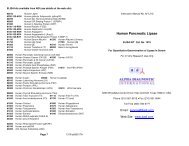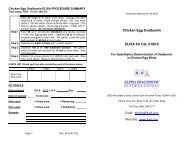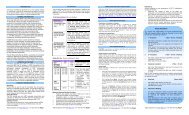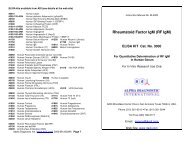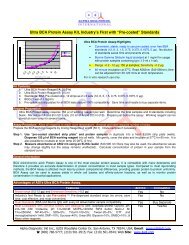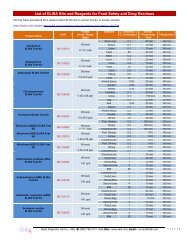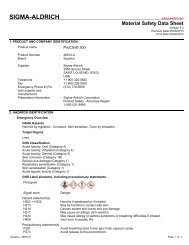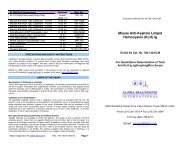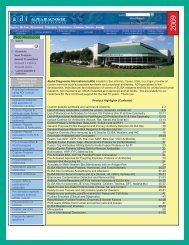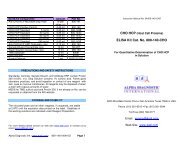Bovine Lactoferrin - Alpha Diagnostic International Inc.
Bovine Lactoferrin - Alpha Diagnostic International Inc.
Bovine Lactoferrin - Alpha Diagnostic International Inc.
You also want an ePaper? Increase the reach of your titles
YUMPU automatically turns print PDFs into web optimized ePapers that Google loves.
PERFORMANCE CHARACTERISTICS (continued)<br />
Sample Recovery<br />
High and low concentrations of purified bovine lactoferrin were spiked into each of 3<br />
milk samples. Observed assay values compared to expected values ranged from 96<br />
to 116%, indicating accurate quantification of lactoferrin in bovine milk.<br />
Sample<br />
Expected<br />
ng/ml<br />
Observed<br />
ng/ml<br />
High <strong>Lactoferrin</strong> 58.0<br />
Observed/<br />
Expected<br />
+ Milk A, 52.3 ng/ml 110.4 106.0 96 %<br />
+ Milk B, 53.2ng/ml 111.2 116.0 104 %<br />
Instruction Manual No. M-8090<br />
<strong>Bovine</strong> <strong>Lactoferrin</strong><br />
ELISA Kit Cat. No. 8090<br />
+ NFD Milk, 64.2 ng/ml 109.8 127.0 116 %<br />
Low <strong>Lactoferrin</strong> 16.6<br />
+ Milk A, 52.3 ng/ml 68.9 69.8 101 %<br />
For Quantitative Determination of <strong>Bovine</strong><br />
<strong>Lactoferrin</strong> in Milk and Fluids<br />
+ Milk B, 53.2ng/ml 69.8 75.4 108 %<br />
+ NFD Milk, 64.2 ng/ml 76.2 85.0 111 %<br />
ELISA Kit Components Amount Part No.<br />
Anti-<strong>Bovine</strong> <strong>Lactoferrin</strong> Microwell Strip Plate 8-well 8091<br />
strips (12)<br />
<strong>Bovine</strong> <strong>Lactoferrin</strong> Positive Control 0.65 ml 8092<br />
<strong>Bovine</strong> <strong>Lactoferrin</strong> Standard 10 ng/ml 0.65 ml 8093B<br />
<strong>Bovine</strong> <strong>Lactoferrin</strong> Standard 40 ng/ml 0.65 ml 8093C<br />
<strong>Bovine</strong> <strong>Lactoferrin</strong> Standard 80 ng/ml 0.65 ml 8093D<br />
<strong>Bovine</strong> <strong>Lactoferrin</strong> Standard 120 ng/ml 0.65 ml 8093E<br />
<strong>Bovine</strong> <strong>Lactoferrin</strong> Standard 160 ng/ml 0.65 ml 8093F<br />
Anti-<strong>Bovine</strong> <strong>Lactoferrin</strong> HRP Conjugate (100X) 0.15 ml 8094<br />
Sample Diluent Concentrate (20X) 10 ml SD-20T<br />
Wash Solution Concentrate (100X) 10 ml WB-100<br />
TMB Substrate 12 ml 80091<br />
Stop Solution 12 ml 80101<br />
Product Manual 1 ea M-8090<br />
For more details please consult our web site (www.4adi.com) or contact us by email<br />
(service@4adi.com).<br />
6203 Woodlake Center Drive • San Antonio• Texas 78244 • USA.<br />
Phone (210) 561-9515 • Fax (210) 561-9544<br />
Toll Free (800) 786-5777<br />
Email: service@4adi.com<br />
Web Site: www.4adi.com<br />
<strong>Alpha</strong> <strong>Diagnostic</strong> Intl (www.4adi.com) Rev. 8090/110211G Page 7
INTENDED USE<br />
The <strong>Bovine</strong> <strong>Lactoferrin</strong> ELISA Kit is an in vitro immunoassay for the quantification of<br />
lactoferrin in milk and colostrums, or in other appropriately qualified samples from<br />
tissue fluids (e.g., saliva, mucosa), or other solutions.<br />
RESEARCH USE OF THE TEST<br />
<strong>Lactoferrin</strong> is a natural, lactose-free, protein present in milk, which has a high<br />
affinity for iron. <strong>Lactoferrin</strong> is a versatile protein that can prevent the growth of<br />
pathogenic bacteria in the gut, and control cell or tissue damage. <strong>Lactoferrin</strong> also<br />
serves as a bio-regulator of iron and provides supportive functions for the immune<br />
system.<br />
Iron is a key mineral required by many micro-organisms for maintenance and<br />
growth. Regulation of iron by lactoferrin in the digestive tract helps to maintain the<br />
correct balance of beneficial and harmful bacteria. <strong>Lactoferrin</strong> binds free iron and<br />
works with the immune system to achieve homeostasis. <strong>Lactoferrin</strong> delivers bound<br />
iron to beneficial bacteria and healthy cells by way of transferrin and helps maintain<br />
the current iron level by a complex biological process involving ferritin and<br />
transferrin. <strong>Lactoferrin</strong> decreases free, non-absorbed iron that would be otherwise<br />
available to pathogens.<br />
<strong>Lactoferrin</strong> has also been shown to inhibit certain cytokine and interleukin<br />
production, which allows for the reduction of swelling and the increase of circulatory<br />
activity in the vicinity of injury.<br />
PRINCIPLE OF THE TEST<br />
The <strong>Bovine</strong> <strong>Lactoferrin</strong> ELISA kit is based on the binding of bovine lactoferrin in<br />
samples to two antibodies, one immobilized on the microtiter wells, and the other<br />
conjugated to horseradish peroxidase (HRP) enzyme. After a washing step,<br />
chromogenic substrate is added and color is developed by the enzymatic reaction of<br />
HRP on the TMB substrate, which is directly proportional to the amount of lactoferrin<br />
present in the sample. Stopping Solution is added to terminate the reaction, and<br />
absorbance at 450nm is then measured using an ELISA microtiter well reader. The<br />
concentration of lactoferrin in samples and control is calculated from a curve of<br />
standards containing known concentrations of lactoferrin.<br />
STORAGE AND STABILITY<br />
The microtiter well plate and all other reagents, if unopened, are stable at 2-<br />
8 o C until the expiration date printed on the box label. Stabilities of the<br />
working solutions are indicated under Reagent Preparation.<br />
PERFORMANCE CHARACTERISTICS<br />
Specificity<br />
The antibodies used in this kit have been shown by immunoelectrophoresis and<br />
ELISA to react specifically with lactoferrin, and have essentially no reactivity with<br />
any other bovine serum or milk proteins. Human and goat milk showed essentially<br />
no reactivity at a 1:10 dilution.<br />
Normal Range<br />
Assay of lactoferrin in ten (10) bovine milk samples ranged from 27 to 165 ug/ml;<br />
1% nonfat dry milk measured 13ug/ml. Each laboratory should determine expected<br />
values of its own testing population.<br />
Precision<br />
Samples containing low, medium and high concentrations of lactoferrin were<br />
assayed multiple times in the same assay (n=10) to provide within-assay precision,<br />
and as duplicates in multiple assays (n=5) to obtain between-assay reproducibility.<br />
Coefficient of variations were calculated for the concentrations using a point-topoint<br />
curve-fitting program.<br />
<strong>Lactoferrin</strong> concentrations were measured with very good within-assay (3.4 to 5.3<br />
%CV) and between-assay (3.4 to 5.3 %CV) reproducibility.<br />
<strong>Lactoferrin</strong> Intra-assay Inter-assay<br />
Sample<br />
ng/ml<br />
%CV<br />
%CV<br />
Low <strong>Lactoferrin</strong> 13.9 4.5 5.3<br />
Medium <strong>Lactoferrin</strong> 44.9 3.8 4.2<br />
High <strong>Lactoferrin</strong> 95.0 4.3 3.4<br />
Linearity of Dilution<br />
Two (2) milk samples and one (1) nonfat dried milk sample were diluted to 2 levels<br />
for testing, and concordance of the assay values were compared. The mean<br />
recovery ranged from 93 to 96%, demonstrating linear dilution and equivalent<br />
quantification across the standard range.<br />
Sample<br />
Dilution<br />
Milk Sample A 1:500<br />
1:2000<br />
Milk Sample B 1:500<br />
1:2000<br />
Nonfat Dry Milk 1:150<br />
1:1200<br />
Continued on Page 7.<br />
Assay Value<br />
ng/ml<br />
98.4<br />
22.7<br />
47.3<br />
13.6<br />
80.0<br />
11.5<br />
Milk Value<br />
mg/ml<br />
49.2<br />
45.4<br />
23.7<br />
27.2<br />
12.0<br />
13.8<br />
Concordance<br />
96 %<br />
93 %<br />
93 %<br />
<strong>Alpha</strong> <strong>Diagnostic</strong> Intl (www.4adi.com) Rev. 8090/110211G Page 1<br />
<strong>Alpha</strong> <strong>Diagnostic</strong> Intl (www.4adi.com) Rev. 8090/110211G Page 6
CALCULATION OF RESULTS<br />
1. The results may be calculated using any immunoassay software package. The fourparameter<br />
curve-fit is recommended. If software is not available, lactoferrin<br />
concentrations may be determined as follows:<br />
2. Calculate the mean OD of duplicate samples.<br />
3. On graph paper plot the mean OD of the standards (y-axis) against the concentration<br />
(ng/ml) of lactoferrin (x-axis). Draw the best fit curve through these points to construct the<br />
standard curve. A point-to-point construction is most common and reliable.<br />
4. The lactoferrin concentrations in unknown samples and controls can be determined by<br />
interpolation from the standard curve.<br />
5. Multiply the values obtained for the samples by the dilution factor of each sample.<br />
6. Samples producing signals higher than the 160 ng/ml standard should be further diluted<br />
and re-assayed.<br />
TYPICAL RESULTS<br />
The following data are for illustration purposes only. A complete standard curve should be run<br />
in every assay to determine sample values.<br />
Wells Standards, Control & Samples A450 nm<br />
lactoferrin<br />
ng/ml<br />
A1, A2 Negative Diluent Control 0.08 0<br />
B1, B2 10 ng/ml Standard 0.16 10<br />
C1, C2 40 ng/ml Standard 0.49 40<br />
D1, D2 80 ng/ml Standard 1.12 80<br />
E1, E2 120 ng/ml Standard 1.70 120<br />
F1, F2 160 ng/ml Standard 2.40 160<br />
G1, G2 Positive Serum Control<br />
1.36 101<br />
[Value: 70 - 130 ng/ml]<br />
H1, H2 Sample [Diluted 1:1000] 0.72 51.3<br />
Calculated: 1000-fold dilution x 51.3 ng/ml = 51.3 ug/ml in milk<br />
A typical assay Standard Curve (do not use for calculating sample values)<br />
To Be Reconstituted: Store as indicated.<br />
Component<br />
Sample Diluent<br />
Concentrate (20x)<br />
Cat. No. SD-20T, 10ml<br />
Wash Solution<br />
Concentrate (100x)<br />
Cat. No. WB-100, 10ml<br />
Anti-<strong>Bovine</strong><br />
lactoferrin - HRP<br />
Conjugate<br />
Concentrate (100x)<br />
Part No. 8094, 0.15ml<br />
KIT CONTENTS<br />
Ready For Use: Store as indicated on labels.<br />
Component<br />
Anti-<strong>Bovine</strong><br />
<strong>Lactoferrin</strong><br />
Microwell Strip<br />
Plate<br />
<strong>Bovine</strong> <strong>Lactoferrin</strong> Standards<br />
10 ng/ml 8093B<br />
40 ng/ml 8093C<br />
80 ng/ml 8093D<br />
120 ng/ml 8093E<br />
160 ng/ml 8093F<br />
Instructions for Use<br />
Dilute the entire volume, 10ml + 190ml with distilled or<br />
deionized water into a clean stock bottle. Label as<br />
Working Sample Diluent and store at 2-8 o C until the<br />
kit lot expires or is used up.<br />
Dilute the entire volume 10ml + 990ml with distilled or<br />
deionized water into a clean stock bottle. Label as<br />
Working Wash Solution and store at RT until kit is<br />
used entirely.<br />
Peroxidase conjugated anti-bovine lactoferrin in buffer<br />
with protein, detergents and antimicrobial as<br />
stabilizers. Dilute fresh as needed; 10ul of<br />
concentrate to 1ml of Working Sample Diluent is<br />
sufficient for 1 8-well strip. Use within the working day<br />
and discard. Return concentrate to 2-8 o C storage.<br />
Part Amt<br />
No.<br />
8091 8-well<br />
strips<br />
(12)<br />
0.65 ml<br />
0.65 ml<br />
0.65 ml<br />
0.65 ml<br />
0.65 ml<br />
Contents<br />
Coated with purified anti-bovine<br />
lactoferrin antibodies.<br />
Five (5) vials, each containing<br />
calibrated lactoferrin<br />
concentrations; diluted in buffer<br />
with protein, detergents and<br />
antimicrobial as stabilizers.<br />
Positive Control<br />
[lactoferrin] range<br />
on label<br />
8092 0.65 ml <strong>Bovine</strong> lactoferrin with stated<br />
concentration range; diluted in<br />
buffer with protein, detergents and<br />
antimicrobial as stabilizers.<br />
TMB Substrate 80091 12 ml Chromogenic substrate for HRP<br />
containing TMB and peroxide.<br />
Stop Solution 80101 12 ml 1% sulfuric acid.<br />
<strong>Alpha</strong> <strong>Diagnostic</strong> Intl (www.4adi.com) Rev. 8090/110211G Page 5<br />
<strong>Alpha</strong> <strong>Diagnostic</strong> Intl (www.4adi.com) Rev. 8090/110211G Page 2
Materials Required But Not Provided:<br />
Pipettors and pipettes that deliver 100ul and 1-10ml. A multi-channel pipettor is<br />
recommended.<br />
Disposable glass or plastic 5-15ml tubes for diluting samples and anti-bovine lactoferrin-<br />
HRP Concentrate.<br />
Graduated cylinder to dilute Wash Concentrate and Sample Diluent concentrate; 200ml to<br />
1L.<br />
Stock bottle to store diluted Wash Solution; 200ml to 1L.<br />
Distilled or deionized water to dilute reagent concentrates.<br />
Microwell plate reader at 450 nm wavelength.<br />
SPECIMEN COLLECTION AND HANDLING<br />
Milk, colostrum and other biological fluids may be used as samples with proper dilution to<br />
avoid solution matrix interference. For all samples, clarify by centrifugation and/or filtration prior<br />
to dilution in Working Sample Diluent. If samples will not be assayed immediately, store<br />
refrigerated for up to a few weeks, or frozen for long-term storage. Avoid freeze-thaw cycles.<br />
PRECAUTIONS AND SAFETY INSTRUCTIONS<br />
Standards, Controls, Sample Diluent, and Anti-bovine lactoferrin-HRP contain<br />
Bromonitrodioxane (BND: 0.05%, w/v). Stop Solution contains 1% sulfuric acid. Follow good<br />
laboratory practices, and avoid ingestion or contact of any reagent with skin, eyes or mucous<br />
membranes. All reagents may be disposed of down a drain with copious amounts of water.<br />
MSDS for TMB, sulfuric acid and BND, if not already on file, can be requested or obtained<br />
from the ADI website.<br />
QUALITY CONTROL<br />
Reagents Accurate and reproducible assay results rely on proper storage, handling and<br />
control of reagent and sample temperature. Store all reagents as indicated, and warm to room<br />
temperature only those to be used in the assay. Shelf-life of the critical reagents and samples<br />
will diminish with extended exposure to non-refrigeration, resulting in inaccurate assay results.<br />
All solutions should be clear. Cloudiness or particulates are indications of reagent<br />
contamination or instability and may interfere with proper performance of the assay. Do not<br />
use.<br />
Sample Controls A Positive Serum Control is provided with the kit, assigned with a lactoferrin<br />
concentration value range. Recovery in this range is an indicator of proper assay performance.<br />
Each lab should also assay internal control samples, which represent the lab’s expected<br />
sample population and that are maintained stabilized. A Negative Diluent Control should also<br />
be run; blank signal should be



